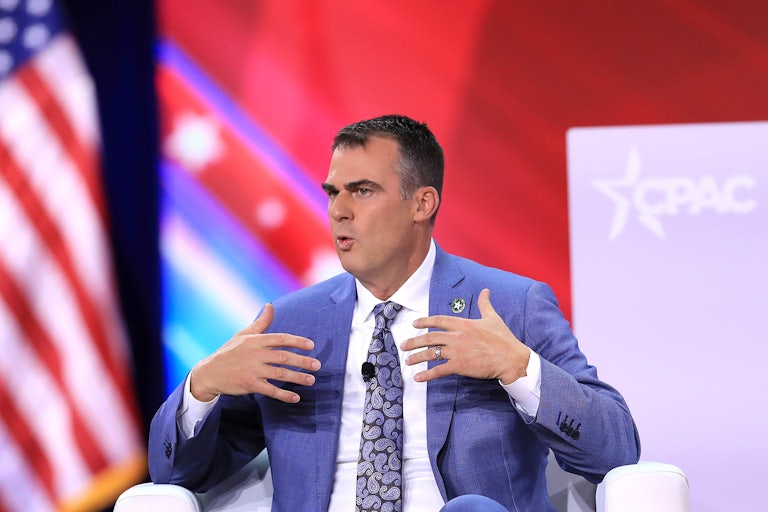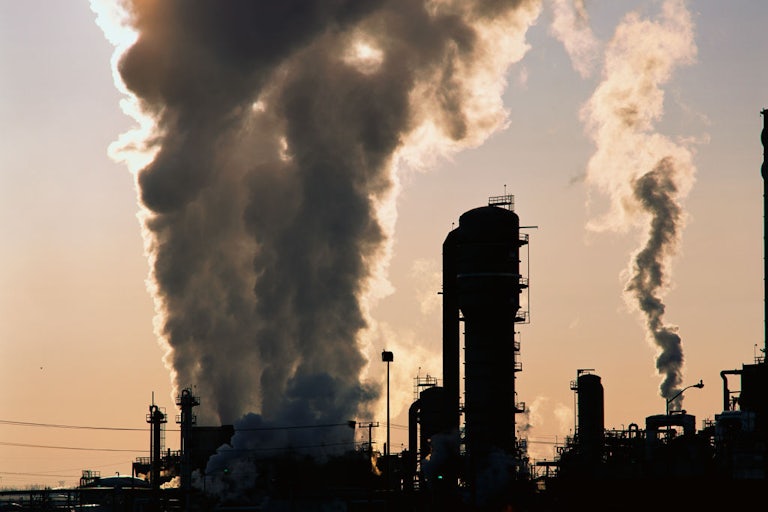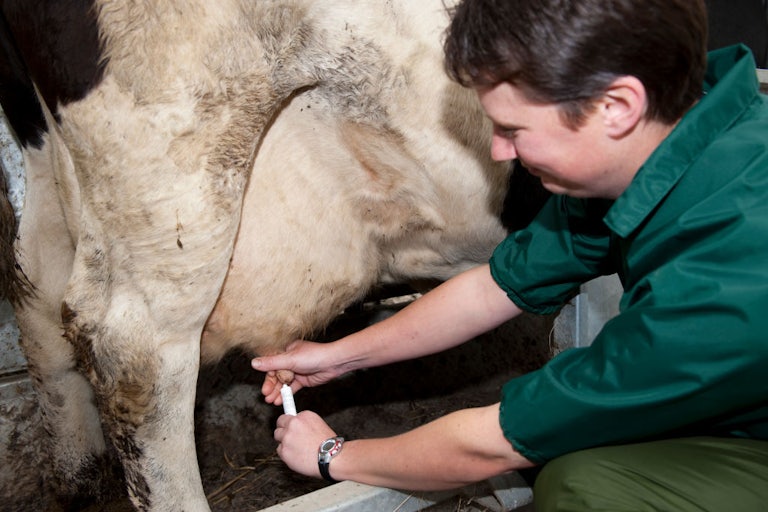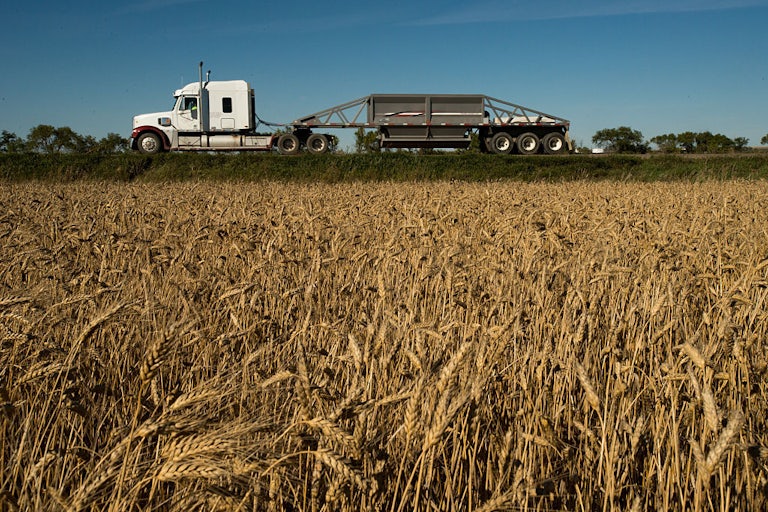Being Against Poop in Rivers Is Now “Un-American”
Oklahoma Governor Kevin Stitt has an unusual interpretation of Oklahoma v. Tyson.

If a company fills a river with bird poop to the point that fish in nearby lakes asphyxiate, is it “un-American” to sue them? Oklahoma Republican Governor Kevin Stitt thinks so. Last week, he signed a law that makes it impossible to sue a poultry company for pollution as long as it has a “Nutrient Management Plan” that complies with state requirements.
“You can’t have a business have a permit, doing what they’re supposed to do, and then come in and let a frivolous lawsuit take place and somehow put them out of business. That’s un-American. It’s not going to happen in Oklahoma,” local news channel KFOR reported Stitt saying. “We had a former Attorney General that sued the chicken industry even though they were following all the rules at the time, saying they should have done something different.”
You may be wondering what all this is about. Stitt was referring to a case that began almost two decades ago: Oklahoma v. Tyson Foods. Not everyone would agree with Stitt’s description of what happened there.
In 2005, then–Oklahoma Attorney General Drew Edmondson, a Democrat, sued 11 companies over the pollution of the Illinois River. The companies, the case alleged, were spreading large amounts of chicken waste and bedding over cropland in the Illinois River Watershed, which covers parts of eastern Oklahoma and northwest Arkansas. While using chicken waste as fertilizer is allowed in some situations, this quantity of chicken waste, the state argued, led to high amounts of phosphorus runoff that polluted local waterways and, in turn, led to an overgrowth of algae and lower dissolved oxygen levels. Fish died, the Illinois River looked and smelled gross, the quality of the drinking water produced by the watershed suffered, and populations of fish and other wildlife in Lake Tenkiller declined.
“Frivolous” (Stitt’s word above) is an odd adjective to describe that lawsuit. Thirteen years after the trial ended in 2009, U.S. District Judge Gregory Frizzell finally ruled in 2023 that the state was right about almost everything. While the state couldn’t prove the bit about the quality of the drinking water, he said, the phosphorus levels, algae levels, wildlife death, and aesthetic degradation were clear, and Frizzell didn’t find the companies’ argument that they were following the law very compelling.
“Historically, defendants have done little—if anything—to provide for or ensure appropriate handling or management of the poultry waste,” he wrote. They “knew or should have known no later than the late 1990s that their growers’ land application of litter was a primary source of the excess phosphorus in the waters,” at which point they were obligated to take action or else fall afoul of state and federal public nuisance law, which stipulates that you’re not allowed to interfere with the public’s use and enjoyment of these waterways. And Oklahoma state law makes it clear, the judge added, that even if companies are following a strict pounds-per-acre regimen for chicken litter, “litter must be applied in a manner that will prevent pollution of State waters.”
Implying, as Governor Stitt did last week, that these sorts of lawsuits are putting law-abiding mom-and-pop shops out of business is also a little odd. Four of the companies named were either Tyson Foods or its subsidiaries. Tyson is the second-largest food company in the nation, right behind PepsiCo, and among the top 10 largest food companies in the world. Another two were Cargill and its subsidiary Cargill Turkey Production. Cargill is the largest privately held company in the country, with an estimated value of around $60 billion. Then there’s Cal-Maine Foods, with revenue above $1.3 billion, which was among those found liable in 2023 for conspiring with other companies to raise egg prices. And George’s Inc and George’s Foods LLC, which cut a $5.8 million deal with the Department of Justice last May as part of the department’s inquiry into poultry companies (including Cargill, which settled for $15 million) conspiring to suppress workers’ wages. Peterson Farms and Simmons Foods admittedly don’t have quite this sort of profile, although obviously no company that can recall 13 tons of TGI Friday’s boneless chicken bites, as Simmons did in December, is small.
The companies in question are now upset that they’re being told to pay to fix something that happened a long time ago—an objection that sort of cuts both ways, since the people affected by their actions are probably mad that it took this long too. The tribal governments of the Cherokee, Chickasaw, Choctaw, Muscogee (Creek), and Seminole Nations have denounced the new law giving the poultry industry immunity from these sorts of lawsuits. This is the background to Stitt’s remarks declaring these suits “un-American.”
The Oklahoma case is part of a bigger picture. Protecting lakes, rivers, and drinking water is actually extremely popular. Polls typically find higher support for that than for fighting climate change. But as TNR’s Kate Aronoff and others have repeatedly observed, the legal system is typically much more favorable to corporations than to their victims—human or animal.
Oklahoma has now made that system even more favorable to corporations. It’s one in a series of recent news events indicating that even the most clear-cut, commonsense moves to protect the public are going to be fought tooth and nail. On Monday, industry groups sued the federal government over a new standard to keep PFAS—chemicals “associated with developmental delays in children, decreased fertility in women and increased risk of some cancers,” per The New York Times—out of drinking water. I previously wrote about companies’ loud objections to being told they could no longer decaffeinate coffee using a chemical so dangerous that it’s been banned for paint stripping since 2019.
Voters say these issues matter to them. But if that’s the case, they’re going to have to show that at the polls. Relying on administrators and courts to protect them is getting riskier by the day.
Good News/Bad News
![]()
![]()
Stat of the Week
1.5 billion
That’s the number of people around the globe who experienced dangerous heat where they live between January and May of this year, according to The Washington Post.
What I’m Reading
Why a new method of growing food on Mars matters more on Earth
Brazilian astrobiologist Rebeca Gonçalves and her colleagues think an ancient Mayan farming technique could work well for growing food on Mars. And that also means it could work well in some of the increasingly arid, unpredictable climates on Earth:
Intercropping, or growing different crops in close proximity to one another to increase the size and nutritional value of yields, requires less land and water than monocropping, or the practice of continuously planting just one thing. Although common among small farmers, particularly across Latin America, Africa, and China, intercropping remains a novelty in much of the world. This is partly because of the complexity of managing such systems and largely unfounded concerns about yield loss and pest susceptibility. Modern plant breeding programs also tend to focus on individual species and a general trend toward less diversity in the field.
This is a missed opportunity, according to Gonçalves. Evidence suggests intercropping can combat the impacts of climate change and unsustainable farming practices on yields in degraded soils, which comprise as much as 40 percent of the world’s agricultural land. “The potential of intercropping really is very high for solving some of the climate change issues,” she said.
Read Ayurella Horn-Muller’s full report at Grist.
This article first appeared in Life in a Warming World, a weekly TNR newsletter authored by deputy editor Heather Souvaine Horn. Sign up here.








